[Answering Questions] Does removing the nasal cartilage return to normal?
Beauty secrets
Dec 26, 2024
Dec 26, 2024
Nasal silicone removal can be performed for many reasons, from complications after surgery to dissatisfaction with the results. Anyone in a situation where they are forced to remove nasal silicone will wonder whether the removal of nasal silicone will return to normal. This article from Aura will answer the question, provide detailed information, and important notes about the process of nasal silicone removal for you.
Nasal silicone removal can be performed for many reasons, from complications after surgery to dissatisfaction with the results. Anyone in a situation where they are forced to remove nasal silicone will wonder whether the removal of nasal silicone will return to normal. This article from Aura will answer the question, provide detailed information, and important notes about the process of nasal silicone removal for you.
Nasal silicone removal can be performed for many reasons, from complications after surgery to dissatisfaction with the results. Anyone in a situation where they are forced to remove nasal silicone will wonder whether the removal of nasal silicone will return to normal. This article from Aura will answer the question, provide detailed information, and important notes about the process of nasal silicone removal for you.
1. What is nose implant removal?
Before answering whether nose implant removal returns to normal, let's explore what the process of removing a nose implant is! Nose implant removal is a medical procedure aimed at removing the artificial cartilage that has been inserted into the nose during the rhinoplasty procedure. This artificial cartilage is usually made from materials like silicone, Gore-Tex, or other biocompatible materials.
The process of removing the nose implant must be performed by highly skilled and experienced specialist doctors. The procedure requires meticulousness and precision to avoid causing further damage to the nose, while also ensuring the best recovery process for the patient.
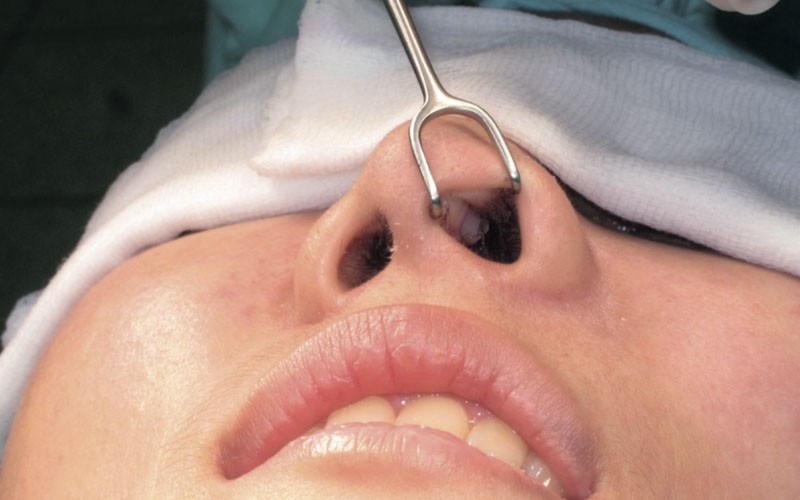
2. Why is nose implant removal necessary?
Why is it necessary to remove the nose implant and whether nose implant removal returns to normal? After rhinoplasty, there are many cases that require the removal of the nose implant. Common cases include:
2.1. Allergic reaction to the nose implant
Although this case is quite rare, allergic reactions to the nose implant can still occur, causing symptoms such as swelling, redness, itching, and pain, even leading to nasal deformities. If not addressed in a timely manner, this condition can lead to serious complications such as infection or necrosis of the nose cartilage. In such cases, removing the nose implant is necessary to prevent serious injuries and protect the patient's health.
2.2. Infection of the nose implant
Infection is one of the most serious complications after rhinoplasty. Signs of infection include prolonged swelling and redness, pus discharge, severe pain, and high fever. If not intervened in time, the infection can cause cartilage necrosis and even threaten life. The cause of the infection often stems from bacteria entering during the surgical process or due to improper post-operative care. Timely removal of the implant is essential to eliminate the source of infection, protect health, and avoid dangerous complications.
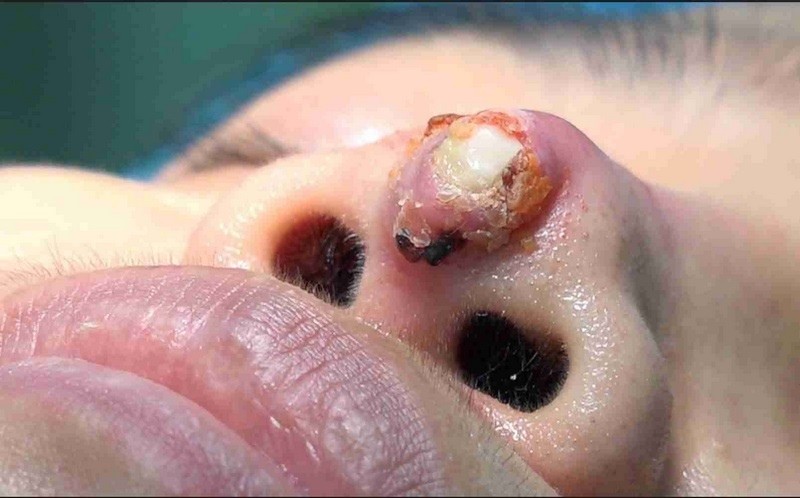
2.3. Visible nose bridge, thin skin
This complication usually appears after performing S-line structural rhinoplasty, when the implant is exposed, causing the tip of the nose to become large, coarse, and unnatural. Thin nasal skin can lead to nasal tip perforation, severely impacting both health and aesthetics. The primary reason for this issue is that the nasal skin is not thick enough to cover the implanted cartilage or due to the contraction of surrounding soft tissues. Removing the implant and applying appropriate treatment measures will help improve this condition.
2.4. Dislocated nose implant
The nose implant can be displaced or tilted due to various factors, such as improper lifting techniques, traumatic injuries after surgery, or individual body characteristics. This condition not only affects aesthetic beauty but can also cause breathing difficulties. Timely intervention by removing the implant will help restore the natural function and shape of the nose.
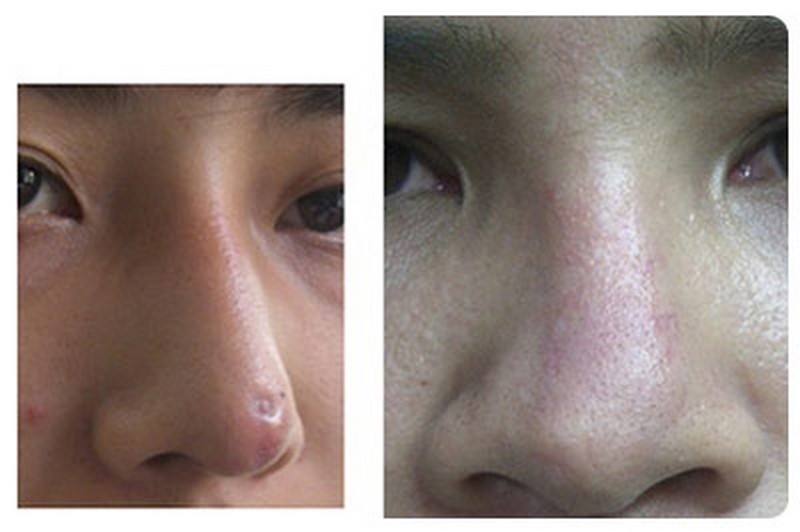
2.5. Dissatisfaction with the results
After rhinoplasty, not everyone feels satisfied with the final results. If you want to adjust the shape of your nose or are unhappy with the current results, removing the nose implant is a necessary step for future revisions.
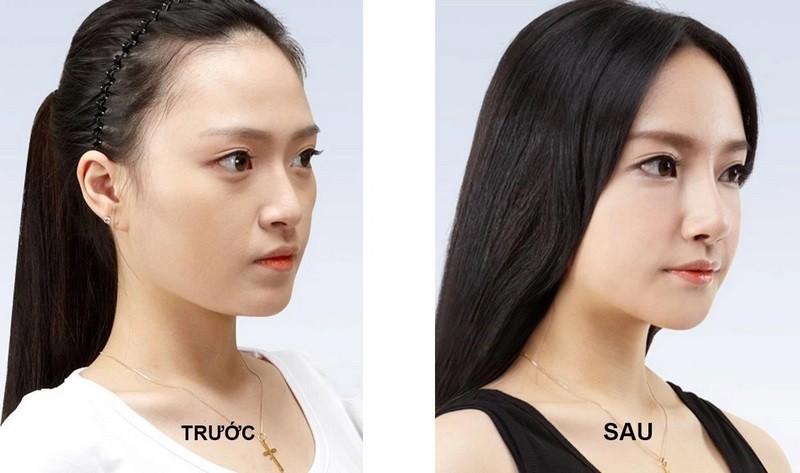
3. Does nose implant removal return to normal?
Nose implant removal is an important decision for those dissatisfied with the results of rhinoplasty or experiencing complications. A common question is whether whether nose implant removal returns to normal? To answer accurately, several factors must be considered:
Complications: If the implant is removed due to complications such as infection, skewed implant, or thin skin, the nose may recover close to its original shape but not entirely as before.
Condition of nasal skin: Thick and elastic skin will help the nose return to a more natural look, while thin, less elastic skin may make scars more evident.
Type of implant: The type of implant used in the initial surgery can significantly affect the patient's recovery process. Artificial cartilage generally causes less distortion or major changes after removal compared to the cartilage taken from the patient's own body (autologous implant). Therefore, choosing the right type of implant is crucial to ensuring optimal surgical results and shortening recovery time.
Post-removal care: Adhering strictly to the doctor's care instructions will help the wound heal faster and reduce the visibility of surgical scars. Conversely, improper care can lead to large surgical scars, swelling, and extend recovery time, thus negatively affecting the aesthetics of the nasal area.
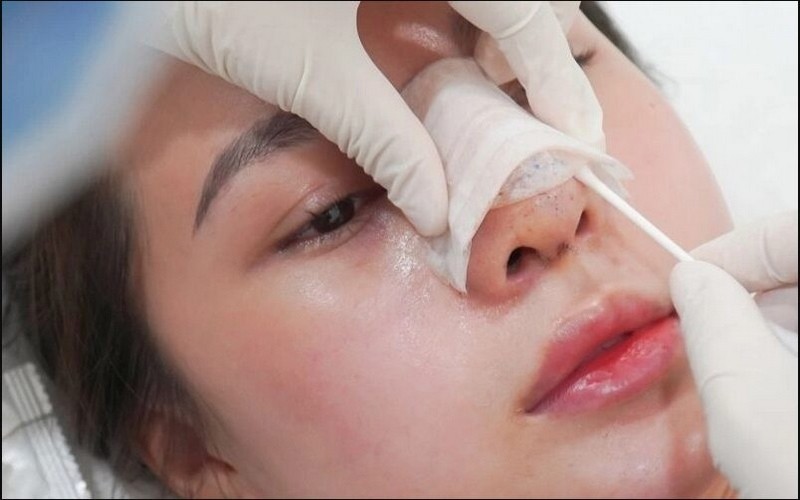
4. How to care after removing the nose implant
Caring after implant removal significantly affects whether the nose can recover completely. Here are some important considerations for post-implant removal care:
4.1. Wound hygiene
Does nose implant removal return to normal depend on how you care for and clean the wound?
Keep the wound always dry and clean.
Clean the wound according to the doctor's instructions, usually using disinfectant solutions or saline solutions.
Avoid strong impact in the nasal area.
Do not actively remove the bandage or stitches.
Only use pain relief and antibiotics as prescribed by the doctor.
4.2. Lifestyle habits
In daily activities, some principles should also be followed.
Take time to rest and get enough sleep.
Minimize physical activities in the first few weeks post-surgery.
Avoid swimming, bathing in the sea, or using steam rooms until the wound heals completely.
Wear sunglasses outdoors to protect the nose from sunlight.
Wear a mask when going out to prevent dust and bacteria from entering the nose.

4.3. Nutrition
Nutrition is an important factor determining whether nose implant removal returns to normal. To support the best recovery process, you need to provide adequate nutrients such as protein, vitamins, and minerals, while also drinking plenty of purified water, fruit juice, and broth to detoxify the body. However, choosing the right beverages is also very important. The issue of “Can I drink coconut water after rhinoplasty??” is detailed at Aura Beauty, helping you gain knowledge for better health care after rhinoplasty. Additionally, you should limit spicy foods, greasy foods, hard foods, alcoholic beverages, and stay away from stimulants to avoid affecting the recovery process.
4.4. Monitor your health condition
Moreover, you need to regularly monitor your health condition and consult your doctor immediately if there are any signs of instability to ensure a return to normal after nose implant removal:
Closely monitor the condition of the wound and inform the doctor if there are abnormal signs such as swelling, bleeding, infection, etc.
Return for follow-up appointments according to the scheduled date to check the recovery progress and receive advice from the doctor.
Additional notes:
Reduce stress, and try to keep a relaxed mindset.
Build and maintain a healthy lifestyle.

5. Frequently asked questions about nose implant removal
Not only are there concerns about whether nose implant removal returns to normal, but Aura has recorded many other concerns from customers. Among them, the most common questions are:
5.1. Is there a risk of the nose retracting after implant removal?
Many people worry about the possibility of the nose retracting after implant removal. The answer depends on the condition of the nose, the reason for implant removal, and the initial lifting method. If the rhinoplasty was standard without complications, the nose is less likely to retract. However, if strong intervention methods were applied, the risk of the nose tip retracting may be higher. The doctor will provide detailed advice for each case.
5.2. Are there any risks associated with nose implant removal?
Risks and complications can include swelling, pain, bruising, infection, or temporary loss of sensation in the nasal area. However, these issues are usually temporary and can be effectively treated.
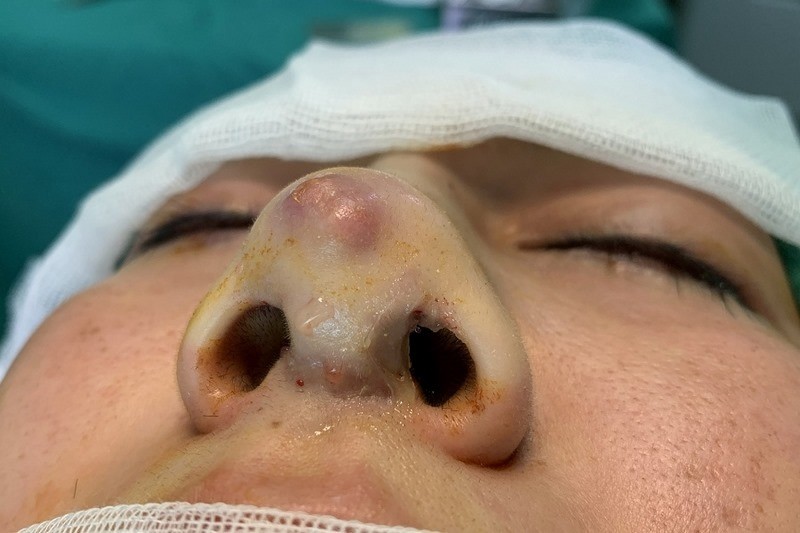
5.3. How long after nose implant removal can the implant be reinserted?
Does nose implant removal return to normal? To return to normal, you need to undergo the surgery to reinsert the nose implant afterward.
Implant removal for aesthetic reasons: If the customer is dissatisfied with the new nose shape or if the nose is skewed, the doctor will perform surgery to create a new nose shape as requested.
Implant removal due to complications: When there is inflammation or allergic reactions to the materials, the doctor will remove the implant and clean the nasal cavity. After 3–6 months when the nose stabilizes, rhinoplasty can be performed again. The longer the implant is removed, the easier it is to reinstate.
5.4. What will the nose look like after removing the implant?
If only the bridge and tip of the nose were lifted, the skin will gradually return to its natural structure after implant removal without much change. However, if there was adjustment of the nasal bones or elevation of the tip (especially with a short or upturned nose), the nose may find it hard to revert to its original form. In some cases, retaining some grafts may be necessary to maintain the nose structure. It is important to discuss thoroughly with the doctor about the options for implant removal and your aesthetic goals.

6. Aura Beauty Clinic - Helping you regain confidence with a naturally beautiful nose
A damaged nose or complications after rhinoplasty is something no one desires. However, if you unfortunately find yourself in a position needing to correct the nose shape, don’t worry too much. Aura Beauty, with a system of international-standard equipment, a team of professional doctors with many years of experience in aesthetics, is committed to creating a nose shape that is not only beautiful but also harmonious with your facial features.
Most importantly, at Aura Beauty - one of the leading addresses for rhinoplasty services, you will be able to undergo implant removal using advanced techniques and choose to place a new, higher-quality implant. These include three types of implants:
Artificial cartilage: The most popular choice in rhinoplasty due to reasonable costs and good lift effectiveness.
Autologous cartilage: Cartilage taken from the customer's body, such as ear cartilage or rib cartilage, providing a more natural result but at a higher cost.
Biological cartilage: This type of cartilage is safe and durable, but more expensive than artificial cartilage.
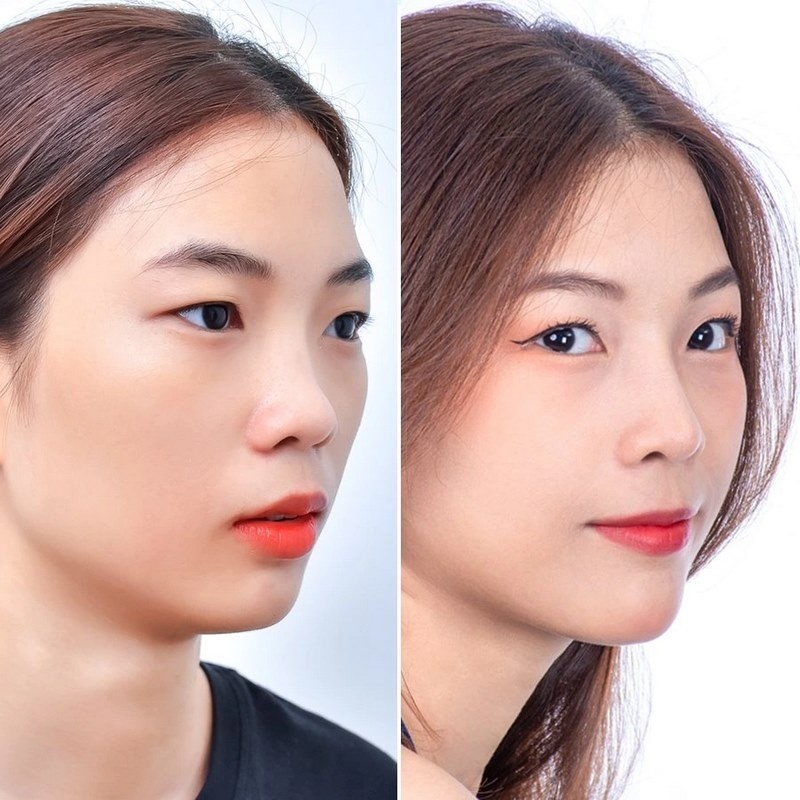
Thus, Aura has helped you answer the question whether nose implant removal returns to normal. It can be seen that to ensure a return to normal after nose implant removal, you need to follow the rules during post-operative care and choose a reputable unit with skilled doctors to perform the procedure.
1. What is nose implant removal?
Before answering whether nose implant removal returns to normal, let's explore what the process of removing a nose implant is! Nose implant removal is a medical procedure aimed at removing the artificial cartilage that has been inserted into the nose during the rhinoplasty procedure. This artificial cartilage is usually made from materials like silicone, Gore-Tex, or other biocompatible materials.
The process of removing the nose implant must be performed by highly skilled and experienced specialist doctors. The procedure requires meticulousness and precision to avoid causing further damage to the nose, while also ensuring the best recovery process for the patient.

2. Why is nose implant removal necessary?
Why is it necessary to remove the nose implant and whether nose implant removal returns to normal? After rhinoplasty, there are many cases that require the removal of the nose implant. Common cases include:
2.1. Allergic reaction to the nose implant
Although this case is quite rare, allergic reactions to the nose implant can still occur, causing symptoms such as swelling, redness, itching, and pain, even leading to nasal deformities. If not addressed in a timely manner, this condition can lead to serious complications such as infection or necrosis of the nose cartilage. In such cases, removing the nose implant is necessary to prevent serious injuries and protect the patient's health.
2.2. Infection of the nose implant
Infection is one of the most serious complications after rhinoplasty. Signs of infection include prolonged swelling and redness, pus discharge, severe pain, and high fever. If not intervened in time, the infection can cause cartilage necrosis and even threaten life. The cause of the infection often stems from bacteria entering during the surgical process or due to improper post-operative care. Timely removal of the implant is essential to eliminate the source of infection, protect health, and avoid dangerous complications.

2.3. Visible nose bridge, thin skin
This complication usually appears after performing S-line structural rhinoplasty, when the implant is exposed, causing the tip of the nose to become large, coarse, and unnatural. Thin nasal skin can lead to nasal tip perforation, severely impacting both health and aesthetics. The primary reason for this issue is that the nasal skin is not thick enough to cover the implanted cartilage or due to the contraction of surrounding soft tissues. Removing the implant and applying appropriate treatment measures will help improve this condition.
2.4. Dislocated nose implant
The nose implant can be displaced or tilted due to various factors, such as improper lifting techniques, traumatic injuries after surgery, or individual body characteristics. This condition not only affects aesthetic beauty but can also cause breathing difficulties. Timely intervention by removing the implant will help restore the natural function and shape of the nose.

2.5. Dissatisfaction with the results
After rhinoplasty, not everyone feels satisfied with the final results. If you want to adjust the shape of your nose or are unhappy with the current results, removing the nose implant is a necessary step for future revisions.

3. Does nose implant removal return to normal?
Nose implant removal is an important decision for those dissatisfied with the results of rhinoplasty or experiencing complications. A common question is whether whether nose implant removal returns to normal? To answer accurately, several factors must be considered:
Complications: If the implant is removed due to complications such as infection, skewed implant, or thin skin, the nose may recover close to its original shape but not entirely as before.
Condition of nasal skin: Thick and elastic skin will help the nose return to a more natural look, while thin, less elastic skin may make scars more evident.
Type of implant: The type of implant used in the initial surgery can significantly affect the patient's recovery process. Artificial cartilage generally causes less distortion or major changes after removal compared to the cartilage taken from the patient's own body (autologous implant). Therefore, choosing the right type of implant is crucial to ensuring optimal surgical results and shortening recovery time.
Post-removal care: Adhering strictly to the doctor's care instructions will help the wound heal faster and reduce the visibility of surgical scars. Conversely, improper care can lead to large surgical scars, swelling, and extend recovery time, thus negatively affecting the aesthetics of the nasal area.

4. How to care after removing the nose implant
Caring after implant removal significantly affects whether the nose can recover completely. Here are some important considerations for post-implant removal care:
4.1. Wound hygiene
Does nose implant removal return to normal depend on how you care for and clean the wound?
Keep the wound always dry and clean.
Clean the wound according to the doctor's instructions, usually using disinfectant solutions or saline solutions.
Avoid strong impact in the nasal area.
Do not actively remove the bandage or stitches.
Only use pain relief and antibiotics as prescribed by the doctor.
4.2. Lifestyle habits
In daily activities, some principles should also be followed.
Take time to rest and get enough sleep.
Minimize physical activities in the first few weeks post-surgery.
Avoid swimming, bathing in the sea, or using steam rooms until the wound heals completely.
Wear sunglasses outdoors to protect the nose from sunlight.
Wear a mask when going out to prevent dust and bacteria from entering the nose.

4.3. Nutrition
Nutrition is an important factor determining whether nose implant removal returns to normal. To support the best recovery process, you need to provide adequate nutrients such as protein, vitamins, and minerals, while also drinking plenty of purified water, fruit juice, and broth to detoxify the body. However, choosing the right beverages is also very important. The issue of “Can I drink coconut water after rhinoplasty??” is detailed at Aura Beauty, helping you gain knowledge for better health care after rhinoplasty. Additionally, you should limit spicy foods, greasy foods, hard foods, alcoholic beverages, and stay away from stimulants to avoid affecting the recovery process.
4.4. Monitor your health condition
Moreover, you need to regularly monitor your health condition and consult your doctor immediately if there are any signs of instability to ensure a return to normal after nose implant removal:
Closely monitor the condition of the wound and inform the doctor if there are abnormal signs such as swelling, bleeding, infection, etc.
Return for follow-up appointments according to the scheduled date to check the recovery progress and receive advice from the doctor.
Additional notes:
Reduce stress, and try to keep a relaxed mindset.
Build and maintain a healthy lifestyle.

5. Frequently asked questions about nose implant removal
Not only are there concerns about whether nose implant removal returns to normal, but Aura has recorded many other concerns from customers. Among them, the most common questions are:
5.1. Is there a risk of the nose retracting after implant removal?
Many people worry about the possibility of the nose retracting after implant removal. The answer depends on the condition of the nose, the reason for implant removal, and the initial lifting method. If the rhinoplasty was standard without complications, the nose is less likely to retract. However, if strong intervention methods were applied, the risk of the nose tip retracting may be higher. The doctor will provide detailed advice for each case.
5.2. Are there any risks associated with nose implant removal?
Risks and complications can include swelling, pain, bruising, infection, or temporary loss of sensation in the nasal area. However, these issues are usually temporary and can be effectively treated.

5.3. How long after nose implant removal can the implant be reinserted?
Does nose implant removal return to normal? To return to normal, you need to undergo the surgery to reinsert the nose implant afterward.
Implant removal for aesthetic reasons: If the customer is dissatisfied with the new nose shape or if the nose is skewed, the doctor will perform surgery to create a new nose shape as requested.
Implant removal due to complications: When there is inflammation or allergic reactions to the materials, the doctor will remove the implant and clean the nasal cavity. After 3–6 months when the nose stabilizes, rhinoplasty can be performed again. The longer the implant is removed, the easier it is to reinstate.
5.4. What will the nose look like after removing the implant?
If only the bridge and tip of the nose were lifted, the skin will gradually return to its natural structure after implant removal without much change. However, if there was adjustment of the nasal bones or elevation of the tip (especially with a short or upturned nose), the nose may find it hard to revert to its original form. In some cases, retaining some grafts may be necessary to maintain the nose structure. It is important to discuss thoroughly with the doctor about the options for implant removal and your aesthetic goals.

6. Aura Beauty Clinic - Helping you regain confidence with a naturally beautiful nose
A damaged nose or complications after rhinoplasty is something no one desires. However, if you unfortunately find yourself in a position needing to correct the nose shape, don’t worry too much. Aura Beauty, with a system of international-standard equipment, a team of professional doctors with many years of experience in aesthetics, is committed to creating a nose shape that is not only beautiful but also harmonious with your facial features.
Most importantly, at Aura Beauty - one of the leading addresses for rhinoplasty services, you will be able to undergo implant removal using advanced techniques and choose to place a new, higher-quality implant. These include three types of implants:
Artificial cartilage: The most popular choice in rhinoplasty due to reasonable costs and good lift effectiveness.
Autologous cartilage: Cartilage taken from the customer's body, such as ear cartilage or rib cartilage, providing a more natural result but at a higher cost.
Biological cartilage: This type of cartilage is safe and durable, but more expensive than artificial cartilage.

Thus, Aura has helped you answer the question whether nose implant removal returns to normal. It can be seen that to ensure a return to normal after nose implant removal, you need to follow the rules during post-operative care and choose a reputable unit with skilled doctors to perform the procedure.
1. What is nose implant removal?
Before answering whether nose implant removal returns to normal, let's explore what the process of removing a nose implant is! Nose implant removal is a medical procedure aimed at removing the artificial cartilage that has been inserted into the nose during the rhinoplasty procedure. This artificial cartilage is usually made from materials like silicone, Gore-Tex, or other biocompatible materials.
The process of removing the nose implant must be performed by highly skilled and experienced specialist doctors. The procedure requires meticulousness and precision to avoid causing further damage to the nose, while also ensuring the best recovery process for the patient.

2. Why is nose implant removal necessary?
Why is it necessary to remove the nose implant and whether nose implant removal returns to normal? After rhinoplasty, there are many cases that require the removal of the nose implant. Common cases include:
2.1. Allergic reaction to the nose implant
Although this case is quite rare, allergic reactions to the nose implant can still occur, causing symptoms such as swelling, redness, itching, and pain, even leading to nasal deformities. If not addressed in a timely manner, this condition can lead to serious complications such as infection or necrosis of the nose cartilage. In such cases, removing the nose implant is necessary to prevent serious injuries and protect the patient's health.
2.2. Infection of the nose implant
Infection is one of the most serious complications after rhinoplasty. Signs of infection include prolonged swelling and redness, pus discharge, severe pain, and high fever. If not intervened in time, the infection can cause cartilage necrosis and even threaten life. The cause of the infection often stems from bacteria entering during the surgical process or due to improper post-operative care. Timely removal of the implant is essential to eliminate the source of infection, protect health, and avoid dangerous complications.

2.3. Visible nose bridge, thin skin
This complication usually appears after performing S-line structural rhinoplasty, when the implant is exposed, causing the tip of the nose to become large, coarse, and unnatural. Thin nasal skin can lead to nasal tip perforation, severely impacting both health and aesthetics. The primary reason for this issue is that the nasal skin is not thick enough to cover the implanted cartilage or due to the contraction of surrounding soft tissues. Removing the implant and applying appropriate treatment measures will help improve this condition.
2.4. Dislocated nose implant
The nose implant can be displaced or tilted due to various factors, such as improper lifting techniques, traumatic injuries after surgery, or individual body characteristics. This condition not only affects aesthetic beauty but can also cause breathing difficulties. Timely intervention by removing the implant will help restore the natural function and shape of the nose.

2.5. Dissatisfaction with the results
After rhinoplasty, not everyone feels satisfied with the final results. If you want to adjust the shape of your nose or are unhappy with the current results, removing the nose implant is a necessary step for future revisions.

3. Does nose implant removal return to normal?
Nose implant removal is an important decision for those dissatisfied with the results of rhinoplasty or experiencing complications. A common question is whether whether nose implant removal returns to normal? To answer accurately, several factors must be considered:
Complications: If the implant is removed due to complications such as infection, skewed implant, or thin skin, the nose may recover close to its original shape but not entirely as before.
Condition of nasal skin: Thick and elastic skin will help the nose return to a more natural look, while thin, less elastic skin may make scars more evident.
Type of implant: The type of implant used in the initial surgery can significantly affect the patient's recovery process. Artificial cartilage generally causes less distortion or major changes after removal compared to the cartilage taken from the patient's own body (autologous implant). Therefore, choosing the right type of implant is crucial to ensuring optimal surgical results and shortening recovery time.
Post-removal care: Adhering strictly to the doctor's care instructions will help the wound heal faster and reduce the visibility of surgical scars. Conversely, improper care can lead to large surgical scars, swelling, and extend recovery time, thus negatively affecting the aesthetics of the nasal area.

4. How to care after removing the nose implant
Caring after implant removal significantly affects whether the nose can recover completely. Here are some important considerations for post-implant removal care:
4.1. Wound hygiene
Does nose implant removal return to normal depend on how you care for and clean the wound?
Keep the wound always dry and clean.
Clean the wound according to the doctor's instructions, usually using disinfectant solutions or saline solutions.
Avoid strong impact in the nasal area.
Do not actively remove the bandage or stitches.
Only use pain relief and antibiotics as prescribed by the doctor.
4.2. Lifestyle habits
In daily activities, some principles should also be followed.
Take time to rest and get enough sleep.
Minimize physical activities in the first few weeks post-surgery.
Avoid swimming, bathing in the sea, or using steam rooms until the wound heals completely.
Wear sunglasses outdoors to protect the nose from sunlight.
Wear a mask when going out to prevent dust and bacteria from entering the nose.

4.3. Nutrition
Nutrition is an important factor determining whether nose implant removal returns to normal. To support the best recovery process, you need to provide adequate nutrients such as protein, vitamins, and minerals, while also drinking plenty of purified water, fruit juice, and broth to detoxify the body. However, choosing the right beverages is also very important. The issue of “Can I drink coconut water after rhinoplasty??” is detailed at Aura Beauty, helping you gain knowledge for better health care after rhinoplasty. Additionally, you should limit spicy foods, greasy foods, hard foods, alcoholic beverages, and stay away from stimulants to avoid affecting the recovery process.
4.4. Monitor your health condition
Moreover, you need to regularly monitor your health condition and consult your doctor immediately if there are any signs of instability to ensure a return to normal after nose implant removal:
Closely monitor the condition of the wound and inform the doctor if there are abnormal signs such as swelling, bleeding, infection, etc.
Return for follow-up appointments according to the scheduled date to check the recovery progress and receive advice from the doctor.
Additional notes:
Reduce stress, and try to keep a relaxed mindset.
Build and maintain a healthy lifestyle.

5. Frequently asked questions about nose implant removal
Not only are there concerns about whether nose implant removal returns to normal, but Aura has recorded many other concerns from customers. Among them, the most common questions are:
5.1. Is there a risk of the nose retracting after implant removal?
Many people worry about the possibility of the nose retracting after implant removal. The answer depends on the condition of the nose, the reason for implant removal, and the initial lifting method. If the rhinoplasty was standard without complications, the nose is less likely to retract. However, if strong intervention methods were applied, the risk of the nose tip retracting may be higher. The doctor will provide detailed advice for each case.
5.2. Are there any risks associated with nose implant removal?
Risks and complications can include swelling, pain, bruising, infection, or temporary loss of sensation in the nasal area. However, these issues are usually temporary and can be effectively treated.

5.3. How long after nose implant removal can the implant be reinserted?
Does nose implant removal return to normal? To return to normal, you need to undergo the surgery to reinsert the nose implant afterward.
Implant removal for aesthetic reasons: If the customer is dissatisfied with the new nose shape or if the nose is skewed, the doctor will perform surgery to create a new nose shape as requested.
Implant removal due to complications: When there is inflammation or allergic reactions to the materials, the doctor will remove the implant and clean the nasal cavity. After 3–6 months when the nose stabilizes, rhinoplasty can be performed again. The longer the implant is removed, the easier it is to reinstate.
5.4. What will the nose look like after removing the implant?
If only the bridge and tip of the nose were lifted, the skin will gradually return to its natural structure after implant removal without much change. However, if there was adjustment of the nasal bones or elevation of the tip (especially with a short or upturned nose), the nose may find it hard to revert to its original form. In some cases, retaining some grafts may be necessary to maintain the nose structure. It is important to discuss thoroughly with the doctor about the options for implant removal and your aesthetic goals.

6. Aura Beauty Clinic - Helping you regain confidence with a naturally beautiful nose
A damaged nose or complications after rhinoplasty is something no one desires. However, if you unfortunately find yourself in a position needing to correct the nose shape, don’t worry too much. Aura Beauty, with a system of international-standard equipment, a team of professional doctors with many years of experience in aesthetics, is committed to creating a nose shape that is not only beautiful but also harmonious with your facial features.
Most importantly, at Aura Beauty - one of the leading addresses for rhinoplasty services, you will be able to undergo implant removal using advanced techniques and choose to place a new, higher-quality implant. These include three types of implants:
Artificial cartilage: The most popular choice in rhinoplasty due to reasonable costs and good lift effectiveness.
Autologous cartilage: Cartilage taken from the customer's body, such as ear cartilage or rib cartilage, providing a more natural result but at a higher cost.
Biological cartilage: This type of cartilage is safe and durable, but more expensive than artificial cartilage.

Thus, Aura has helped you answer the question whether nose implant removal returns to normal. It can be seen that to ensure a return to normal after nose implant removal, you need to follow the rules during post-operative care and choose a reputable unit with skilled doctors to perform the procedure.
REGISTER NOW
REGISTER NOW
REGISTER NOW



Author
Dr. Huynh Cong Thanh
Dr. Huỳnh Công Thành has over 12 years of experience in the field of aesthetics and skin treatment for more than 100,000 clients.
See more
See more
You may be interested

Beauty secrets
Can a crooked nose job be corrected? What should be done if it is uneven?

Beauty secrets
Can a crooked nose job be corrected? What should be done if it is uneven?

Beauty secrets
Can a crooked nose job be corrected? What should be done if it is uneven?

Beauty secrets
Can I smile after getting a nose job? How long can I smile comfortably?

Beauty secrets
Can I smile after getting a nose job? How long can I smile comfortably?

Beauty secrets
Can I smile after getting a nose job? How long can I smile comfortably?

Beauty secrets
Can I Drink Milk Tea After Nose Surgery? Experts Explain

Beauty secrets
Can I Drink Milk Tea After Nose Surgery? Experts Explain

Beauty secrets
Can I Drink Milk Tea After Nose Surgery? Experts Explain

Beauty secrets
Decoding the nose shapes in face reading: Destiny, personality

Beauty secrets
Decoding the nose shapes in face reading: Destiny, personality

Beauty secrets
Decoding the nose shapes in face reading: Destiny, personality


